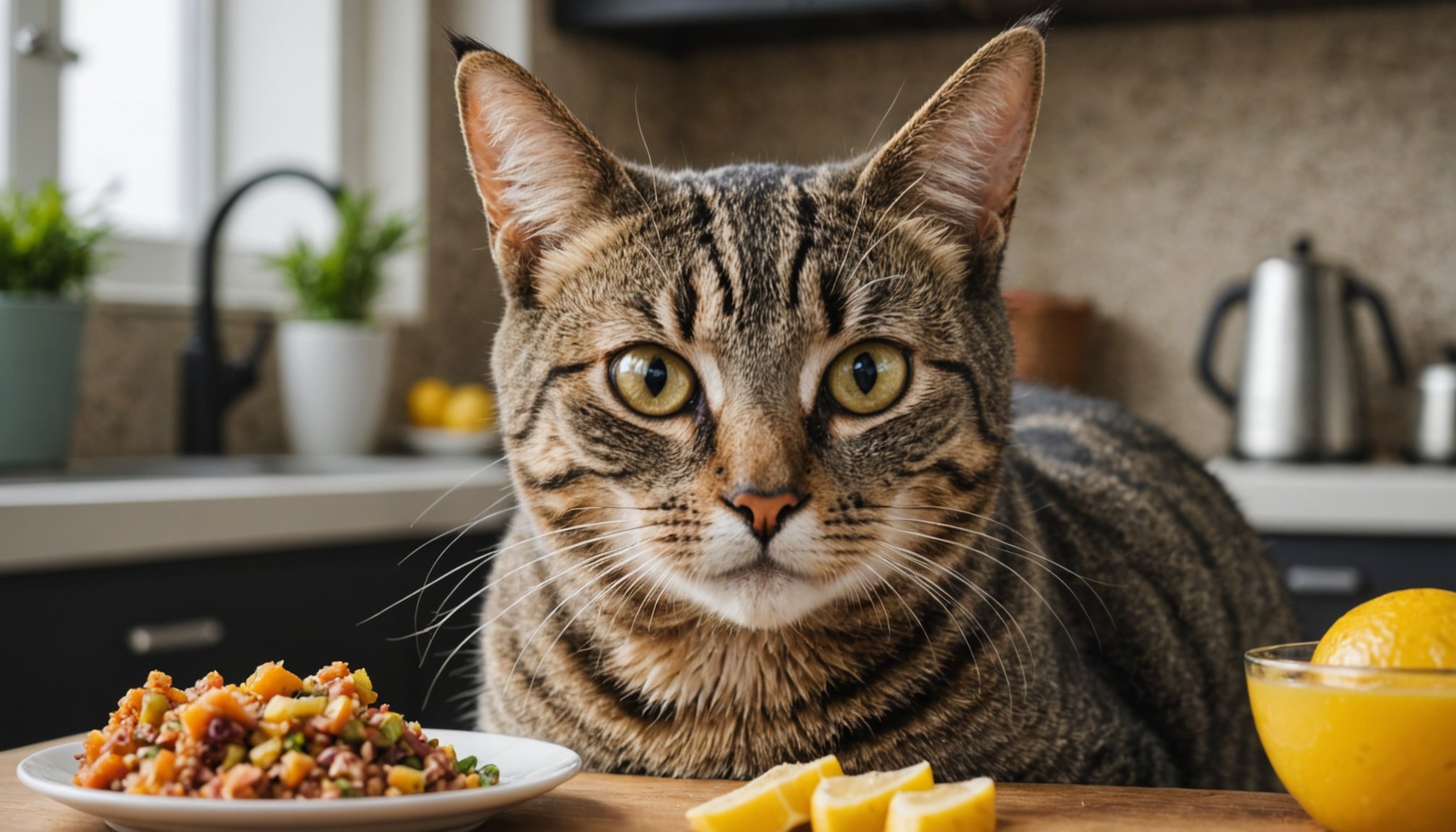Nourishing Your Hyperthyroid Cat: Key Dietary Tips for Optimal Health
If you’ve recently discovered that your feline friend is suffering from hyperthyroidism, you’re likely looking for the best ways to manage this condition and ensure your cat’s health and well-being. Hyperthyroidism, a common endocrine disorder in older cats, can significantly impact your pet’s quality of life. Here’s a comprehensive guide to help you navigate the dietary aspects of caring for your hyperthyroid cat.
Understanding Hyperthyroidism in Cats
Hyperthyroidism occurs when the thyroid gland overproduces the thyroid hormones T3 and T4, leading to a range of symptoms that can be quite distressing for both you and your cat. Common signs include weight loss despite increased appetite, increased thirst and urination, restlessness, rapid heart rate, and an unkempt coat[3].
Also to discover : Introducing a Kitten to Your Canine-Centric Home: Tips for Peaceful Pet Integration
“Hyperthyroidism is the most common endocrine disorder in older cats, affecting about 10% of cats that are 10 years or older,” notes a veterinary expert. Understanding these symptoms is crucial for early diagnosis and effective management.
The Role of Diet in Managing Hyperthyroidism
Diet plays a pivotal role in managing hyperthyroidism in cats. Here are some key dietary tips to ensure your cat receives the best possible care:
Low Iodine Diet
One of the most critical aspects of a hyperthyroid cat’s diet is the restriction of iodine. Iodine is essential for the production of thyroid hormones, so reducing its intake can help decrease the overproduction of these hormones.
“Restricting iodine in a cat’s diet will help reduce the thyroid from overproducing the thyroid hormone, thyroxine, which causes hyperthyroidism,” explains a veterinary nutritionist[1].
High-Protein, Moderate Fat, and Low Carbohydrates
Cats with hyperthyroidism benefit from a diet that is high in protein, moderate in fat, and low in carbohydrates. Here’s a breakdown of what you should look for:
- Protein: 50-70% of the diet should be protein-rich to help your cat maintain muscle mass and overall health.
- Fat: 30-40% of the diet should be fat to provide the necessary calories and support weight gain.
- Carbohydrates: Keep carbohydrates to a minimum, ideally 5-10% of the diet, as they are not essential for feline nutrition[1].
Hydration and Wet Food
Wet food is often recommended for hyperthyroid cats because it provides additional hydration, which is crucial for their overall health. Wet foods are generally lower in carbohydrates and higher in protein and fat, making them a better choice.
“Wet food is often better than dry food for hyperthyroid cats because it provides extra water content and is typically lower in carbohydrates,” advises a pet care expert[4].
Best Foods for Hyperthyroid Cats
Choosing the right food for your hyperthyroid cat can be overwhelming, given the numerous options available. Here are some top recommendations:
Hill’s Prescription Diet y/d Thyroid Care Cat Food
- Flavor: Chicken
- Texture: Pâté (wet) and kibble (dry)
- Protein Content: 8% (wet), 30% (dry)
- Size: Various sizes available
- Key Features: Clinically proven to restore thyroid health in as little as 3 weeks, low in sodium and phosphorus for kidney health, contains omega-3 and -6 for skin and coat health, and taurine and carnitine for heart health.
- Drawbacks: Expensive, requires a vet prescription, contains pork by-products and corn flour[1].
Wellness Complete Health Canned Cat Food
- Flavor: Chicken
- Texture: Pâté
- Protein Content: 10.5%
- Size: Various sizes available
- Key Features: Grain-free, high in omegas and antioxidants, supports immune system and skin/coat health.
- Drawbacks: Some cats may find the texture unappealing, can be expensive[1].
Table: Comparison of Recommended Cat Foods for Hyperthyroidism
| Food | Flavor | Texture | Protein Content | Size | Key Features | Drawbacks |
|---|---|---|---|---|---|---|
| Hill’s Prescription Diet y/d | Chicken | Pâté (wet), kibble (dry) | 8% (wet), 30% (dry) | Various sizes | Clinically proven, low in sodium and phosphorus, omega-3 and -6, taurine and carnitine | Expensive, vet prescription required, contains pork by-products and corn flour |
| Wellness Complete Health | Chicken | Pâté | 10.5% | Various sizes | Grain-free, high in omegas and antioxidants, supports immune system and skin/coat health | Some cats may find texture unappealing, can be expensive |
| Hill’s Prescription Diet y/d (dry) | Chicken | Kibble | 30% | 4 and 8.5 lbs. | Best value, decreases T4 hormone production, supports urinary, heart, and kidney health | Expensive, main ingredient is corn gluten meal |
Practical Tips for Feeding Your Hyperthyroid Cat
Here are some practical tips to make feeding your hyperthyroid cat easier and more effective:
Transitioning to New Food
- Gradual Transition: When switching to a new food, do it gradually to avoid digestive upset. Mix the new food with their current food over a period of 7-10 days.
- Monitor Appetite: Keep a close eye on your cat’s appetite and adjust the transition pace if necessary.
Avoiding High Iodine Foods
- Limit Outdoor Hunting: If your cat hunts outdoors, limit this activity as prey like mice and birds can be high in iodine.
- Avoid Iodine-Rich Foods: Steer clear of foods that are naturally high in iodine, such as fish and dairy products[2].
Hydration
- Ensure Adequate Water: Make sure your cat always has access to fresh water. Wet foods can help increase hydration, but it’s still important to monitor water intake.
- Add Water to Dry Food: If your cat prefers dry food, adding a small amount of water can make it more palatable and increase hydration.
Supplements and Additional Support
While diet is a cornerstone of managing hyperthyroidism, supplements can also play a supportive role:
NHV Natural Supplements
- Resthyro: Formulated to help balance the thyroid and alleviate symptoms of hyperthyroidism.
- Turmeric: Provides heart and liver support.
- Hearty Heart: Helps with blood pressure and circulatory support.
- Milk Thistle: Offers liver support.
- Tripsy: Strengthens the kidneys, which is crucial since hyperthyroidism can often be complicated by kidney disease[3].
Real-Life Examples and Testimonials
Here are some real-life examples of how dietary changes have impacted cats with hyperthyroidism:
Brooklyn’s Story
“After learning our treatment options, we opted to try the diet change as we thought that would be the easiest for Brooklyn. So far, so good Brooklyn really likes her new food and the transition was pretty smooth. Fingers crossed when we go back for a re-check that this treatment is working,” shared a pet owner on Chewy.com[5].
Fanny’s Journey
“Fanny had been on methimazole but started having a bad reaction and had to be taken off. She’s 15, has asthma, an enlarged heart, and hip dysplasia, so she wasn’t a good candidate for the more aggressive treatments. The Hill’s Prescription Diet y/d has been a lifesaver. Her levels dropped from 11 to 2, and she gained a little weight, which she had been steadily losing for about 6 months,” another owner shared[5].
Consulting Your Vet
While this guide provides valuable insights, it’s essential to consult with your veterinarian before making any significant changes to your cat’s diet.
“Methimazole does not cure hyperthyroidism, so a cat diagnosed with the condition will need to be given methimazole for the duration of their life unless they’ve undergone radiation therapy or are well-controlled by exclusively eating a thyroid diet prescribed by a veterinarian,” advises a veterinary expert[2].
Your vet can help you choose the best diet and supplements tailored to your cat’s specific needs and health conditions.
Managing hyperthyroidism in cats requires a multifaceted approach, with diet being a critical component. By understanding the importance of low iodine, high protein, and moderate fat, and by choosing the right foods and supplements, you can significantly improve your cat’s health and quality of life.
Remember, every cat is different, so it’s crucial to monitor your cat’s response to dietary changes and adjust as necessary. With the right diet and veterinary care, your hyperthyroid cat can live a more comfortable and healthy life.

